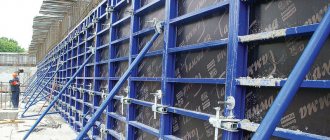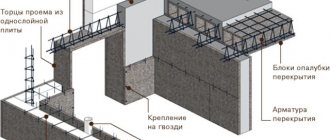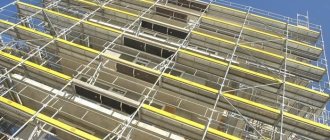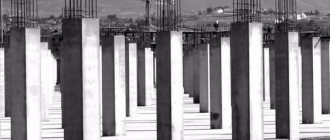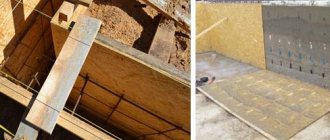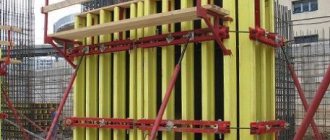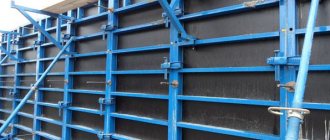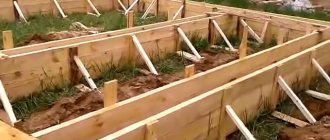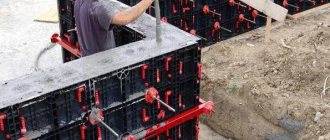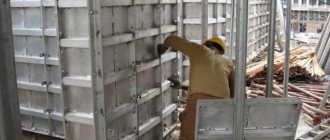For a long time now, small-panel wall formwork has become one of the useful construction technologies that greatly facilitate some work for a person, including those performing it alone. What is small-panel formwork, why is it useful, how is it assembled and installed? This will be useful to know during construction work in your home.
Small panel formwork for foundations in Moscow
Small panel formwork is universal and quite easy to use.
Due to its light weight and versatility, this type of construction is quite popular when performing various types of monolithic work. In addition, small panel formwork does not require the additional use of heavy lifting equipment. Such segments can be combined as easily as possible.
Due to this, it is possible to use small-panel formwork for the construction of foundations or any other objects.
Features of small panel formwork
Small panel formwork is a special structure that consists of panels. These types of elements are made primarily of metal and are equipped with special fasteners designed to make connections in a series manner.
The side parts located on each shield can withstand quite impressive loads during operation. They also have a special embossing, which is necessary in order to ensure more convenient movement.
To eliminate the possibility of corrosion forming on the surface of the metal frame and the negative influence of alkali from concrete, each element of this structure is galvanized. Painting can also be done using a special protective solution.
The result is a high-strength small-panel wall formwork, which ensures the highest level of geometric accuracy. They are designed for reusable use. Therefore, after dismantling work, they can be used on other construction sites.
Features of using small panel formwork
First of all, the installation of formwork is used mainly on those construction sites where it is not possible to use heavy equipment.
Therefore, the main advantage of these structures is that even the largest elements can be installed with just two workers.
It is also often used to create curved surfaces, such as bridges, structures for production facilities or factories. In order to minimize errors, small elements of small-panel formwork are used for the foundation.
Quite often, such systems are used as an alternative to conventional hydraulic jacks. After completing the installation of formwork, pouring is carried out. After the solution hardens, the structure is subsequently removed.
It is important that such structures are produced in full compliance with the current GOST standards. Among the most significant requirements are the presence of high strength and wear resistance, and the presence of easy-to-use locks.
Types of small panel formwork
Today, there are two types of small-panel formwork for foundations. Based on their features, they are divided into modular and collapsible inventory. Each type has its own specific features that should be considered separately.
Modular type
This construction equipment is a system where all elements of the same size will be connected in series. When performing work, special connecting handles are used. The shields weigh 59 kilograms each. Thanks to this, they are able to withstand pressure of 40 kN/m.
Collapsible type
Such construction equipment includes a set of panels and locking connections. Due to the versatility of this design, it can be assembled not only vertically, but also horizontally. All elements weigh about 27 kilograms.
They are used to fill walls, foundations and to create various types of floors. Construction equipment of this type is very popular, since with its use it is possible to give the building the desired shape.
Due to this, this type is perfect for a wide variety of projects.
Pros and cons of small panel formwork
Due to its modest dimensions, the equipment can be used in high-rise construction. The reason is the ability to independently install such a system. Also among the advantages of these structures are:
- availability of the possibility of using shields of different sizes;
- versatility of various fasteners and components;
- there are no difficulties when connecting elements into a single system;
- it is possible to combine elements of different sizes during the work process;
- panel products have high strength indicators;
- structures have a long service life;
- due to the absence of the need to use special equipment during construction work, financial expenses are minimized;
- suitable for the construction of various projects.
- Despite the fact that structures of this type have many advantages, there are also some negative aspects, among which we should highlight:
- When performing installation, it is necessary to involve a large number of workers, because the installation and fastening of the panels is carried out exclusively by hand;
- the appearance of the surfaces is significantly inferior to those created using other types of formwork.
Buy small panel formwork in Moscow
LINEAR SHIELDS
Size (length, height) Unit. unit Price, rub. aluminum (140x60) steel (120x60) galvanized (120x60)
| small panel formwork 1.5 | ||||
| 1.20 x 1.5 m | PC. | 11 057 | 7 000 | 9 461 |
| 1.10 x 1.5 m | PC. | 10 357 | 6 300 | 8 925 |
| 1.00 x 1.5 m | PC. | 10 077 | 6 200 | 8 711 |
| 0.90 x 1.5 m | PC. | 9 657 | 5 800 | 8 390 |
| 0.80 x 1.5 m | PC. | 9 237 | 5 500 | 8 069 |
| 0.75 x 1.5 m | PC. | 9 098 | 5 300 | 7 961 |
| 0.70 x 1.5 m | PC. | 8 678 | 5 200 | 7 640 |
| 0.65 x 1.5 m | PC. | 8 468 | 5 000 | 7,479 |
| 0.60 x 1.5 m | PC. | 8 258 | 4 800 | 7 319 |
| 0.55 x 1.5 m | PC. | 7 978 | 4 600 | 7 105 |
| 0.50 x 1.5 m | PC. | 7 698 | 4 400 | 6 890 |
| 0.45 x 1.5 m | PC. | 7 488 | 4 300 | 6 730 |
| 0.40 x 1.5 m | PC. | 7 353 | 4 200 | 6 569 |
| 0.30 x 1.5 m | PC. | 6 298 | 3 400 | 5 819 |
| 0.25 x 1.5 m | PC. | 6 158 | 3 300 | 5 712 |
EXTERNAL CORNER BOARDS
Size (length, height) Unit. unit Price, rub. aluminum (140x60) steel (120x60) galvanized (120x60)
| small panel formwork 1.5 | ||||
| 0.6 x 0.6 x 1.5 m | PC. | 13 437 | 10 100 | 11 900 |
| 0.5 x 0.5 x 1.5 m | PC. | 11 197 | 8 300 | 10 500 |
INTERNAL CORNER SHIELDS
Size (length, height) Unit. unit Price, rub. aluminum (140x60) steel (120x60) galvanized (120x60)
| small panel formwork 1.5 | ||||
| 0.5 x 0.5 x 1.5 m | PC. | 10 014 | 7 200 | 9 100 |
| 0.3 x 0.3 x 1.5 m | PC. | 8 964 | 5 200 | 7 900 |
CORNER HINGED SHIELDS
Size (length, height) Unit. unit Price, rub. aluminum (140x60) steel (120x60) galvanized (120x60)
| small panel formwork 1.5 | ||||
| 0.5 x 0.5 x 1.5 m | PC. | 11 400 | 9 200 | 8 723 |
| 0.3 x 0.3 x 1.5 m | PC. | 8 633 | 7 300 | 8 100 |
If you need to buy small-panel formwork in Moscow, we recommend that you familiarize yourself with the offers of our company.
Our official website presents small-panel formwork of different sizes, so it will not be difficult for you to find the most suitable option for construction.
We bring to your attention only high-quality and reliable construction equipment, so you can sell it on favorable terms after use.
Our pricing policy is democratic, so you will have the opportunity to buy small-panel formwork at an affordable price. On our website, each item is accompanied by a detailed description, so before purchasing you will have all the necessary information. This will make it much easier for you to make a choice.
If you have any questions during the process of choosing designs, you can ask our consultants. To do this, all you need to do is call our hotline phone number, which is presented on the screen.
Since our staff employs only competent and qualified specialists, you can be sure that you will be provided with detailed and truthful information. In order to buy small-panel formwork, you can also contact our employees by phone, or fill out a simple form.
Our managers will contact you shortly to clarify the details. Delivery takes the shortest possible time from the moment the order is placed. Delivery costs depend on order volume and distance.
Scope of application
First of all, the installation of small-panel formwork from the company Mekos, HSI or PSK, depending on the size of the panels, is often used at those sites where it is not possible to use heavy equipment. This is due to the fact that even the largest elements of such a structure can be installed by two people. In addition, its use is determined by the need to form a curved surface, which includes bridges and various structures in production or factories. In order to achieve minimal errors, just similar small elements of collapsible small-panel formwork are used.
Often such systems are used instead of classic hydraulic jacks. For example, for the construction of low-rise private houses or cottages they are used in the absence of appropriate elements. For this purpose, the formwork is installed, poured, and after the solution has hardened, the structure is removed and mounted in another area. The use of such formwork is used for the construction of:
- Columns;
- Walls or other ceilings;
- Bridges, as well as overpasses;
- Hydration elements;
- Domes, spheres, and other decorative elements.
The options used must be manufactured in accordance with current GOSTs. The requirements for the design are the presence of high strength indicators, as well as easy-to-use locks for small-panel formwork.
Small panel formwork - application, installation, dismantling
Small panel formwork is considered universal and easy to use. Due to its light weight, as well as versatility, such a design is extremely in demand when carrying out various types of construction.
In addition, it does not require the use of lifting equipment for installation. Such segments can be easily combined, which allows the use of small-panel formwork for foundations and other objects of varying complexity.
Description of design
First of all, small panel formwork is a type of structure consisting of panels. Such elements are made of metal or other materials that have special fasteners for connecting them in series.
The side parts of each shield are able to withstand high loads, and for the convenience of moving them vertically, they are specially embossed. In order to prevent corrosion, as well as the negative effects of alkali from concrete, the surface of each element is galvanized or painted with a special protective solution.
The result is a durable small-panel wall formwork that can provide a high level of geometric accuracy and also last at least 300 cycles.
Shields can be connected to each other on any side, which makes them extremely versatile.
The average weight of each element is 50 kg, with dimensions of 2 m2. Ready-to-install boards have a slightly larger weight, reaching up to 60 kg.
Thanks to these parameters, their use is possible without the use of special lifting equipment, even at great heights or depths. The assembled structure can withstand pressure of about 80 kN/m2.
At the same time, the joints are made in such a way as to ensure tightness, as well as to simplify further dismantling of the structure after the concrete has hardened.
Fasteners can be installed at any angle, which allows the use of such formwork to create various forms for pouring.
Scope of application
First of all, the installation of small-panel formwork from the company Mekos, HSI or PSK, depending on the size of the panels, is often used at those sites where it is not possible to use heavy equipment. This is due to the fact that even the largest elements of such a structure can be installed by two people.
In addition, its use is determined by the need to form a curved surface, which includes bridges and various structures in production or factories. In order to achieve minimal errors, just similar small elements of collapsible small-panel formwork are used.
Often such systems are used instead of classic hydraulic jacks.
For example, for the construction of low-rise private houses or cottages they are used in the absence of appropriate elements.
For this purpose, the formwork is installed, poured, and after the solution has hardened, the structure is removed and mounted in another area. The use of such formwork is used for the construction of:
- Columns;
- Walls or other ceilings;
- Bridges, as well as overpasses;
- Hydration elements;
- Domes, spheres, and other decorative elements.
The options used must be manufactured in accordance with current GOSTs. The requirements for the design are the presence of high strength indicators, as well as easy-to-use locks for small-panel formwork.
?
Characteristics and Features
The parameters that finished products must have are specified in GOST R 52085-2003. According to this document, the following requirements are imposed on the formwork elements:
- Products are made of fiberglass, plywood, stainless steel, and moisture-resistant veneer;
- The weight of small panel elements with an area of 1 m2 cannot exceed 25 kg, and with 2 m2 the maximum weight is 60 kg;
- The permissible load when using shields is no more than 80 kN/m2, and the deflection level is 1/400. This allows you to create a foundation with high load-bearing capacity;
Varieties
Today they produce 2 types of large-panel and small-panel formwork, which are modular in design, as well as collapsible and removable inventory. Each option is worth considering.
Modular
Such models are a system in which elements of the same size are connected in series using connecting handles. Each shield weighs 59 kg with dimensions of 1:1.5 meters. This formwork option can withstand a pressure of 40 kN/m.
It is made from special laminated plywood, 18 mm thick. Thanks to such a system, it is possible to create a surface of any shape. Another feature of such options is the possibility of replacing one element if it is very worn out.
When the need arises, the panels can be combined to create a large structure.
Deka's corner small-panel formwork is most in demand for the construction of houses, as well as various public buildings.
Collapsible inventory
Such structures consist of a set of panels, special locking connections, as well as mounting elements. Due to the versatility of this system, its assembly is possible vertically as well as horizontally. Each of the elements weighs about 27 kg, with product dimensions of 0.6:1.8 m.
A collapsible and repositionable structure is used for pouring walls, foundations or other floors. The ability to set the desired angle of the panel connection allows you to create curved surfaces to give the surface the desired architectural shape. Ready-made kits are available for different purposes.
Thus, steel formwork options allow you to build:
- Bridge supports;
- Walls or foundation;
- Shafts or tanks of different sizes;
- Columns or curved surfaces.
Advantages and disadvantages
Due to its small size, Korean small-panel formwork can be used in high-rise construction or in the construction of private buildings whose height is no more than 6 m. This is due to the ability to independently manually install such a system, without resorting to the use of special equipment. Other advantages of such formwork are:
- Possibility to use shields of various sizes;
- The versatility of the components used, as well as fasteners;
- Ease of connecting elements into a single system;
- The ability to combine elements of different sizes;
- High strength of panel products;
- Long service period;
- Saving money and time due to low weight and no need to use special equipment;
- Ease of implementation in various projects.
At the same time, despite the presence of positive aspects, the use of such structures also has its negative aspects:
- Installation requires the involvement of a large number of people who will manually install and secure the boards;
- The appearance of the created surface is an order of magnitude inferior to those options that are created using other types of formwork.
Installation
The procedure for installing such a system is determined by the type of structure itself. So, in order to install collapsible options, you need to perform the following steps:
- First, it is worth carrying out land work, which consists of digging a trench, as well as laying a cushion of sand and crushed stone;
- Next comes the installation of auxiliary elements, shields, as well as special corners;
- Now install adjacent panels, which are secured using spring hooks;
- After this, the finished box is straightened and brought into the desired position;
- The last stage is pouring the concrete mixture into the resulting structure and subsequent deep vibratory ramming of the solution.
In order to prevent expansion of the lower parts of the formwork by the poured mixture, it is important to drive medium-diameter reinforcing bars into the ground at intervals of 1 meter.
?
The installation process for modular options is carried out in the following sequence:
- After preparing the trench, other blocks are connected to the corner shield using fasteners. Due to the springs that are present in the connecting parts, the formation of gaps is prevented;
- Next, the individual walls of the structure are assembled, for which tension bolts are inserted, onto which special plastic tubes are placed to prevent the negative impact of the solution on the metal;
- The last stage is the creation of a supporting frame. To do this, panels installed in parallel are fastened with special connecting locks. Additionally, they are connected at the top and bottom with spacer bars, after which the cement mortar is poured.
Dismantling
The process of dismantling the small-panel formwork structure is carried out in the reverse order.
However, when constructing a large number of similar elements, for example, when the parameters of walls or load-bearing structures are the same on all floors, complete dismantling of the system is not required.
Here, thanks to special brackets located on the upper parts of the shields, the entire structure can be raised to the desired height, and then secured there. In addition, the system can be rearranged in assembled form by simply removing the supporting frame.
The use of small-panel formwork options is a profitable and convenient way to fill a foundation, walls or other elements. This design comes in several types, so it is important to consider the features of each of them.
Description of design
First of all, small panel formwork is a type of structure consisting of panels. Such elements are made of metal or other materials that have special fasteners for connecting them in series. The side parts of each shield are able to withstand high loads, and for the convenience of moving them vertically, they are specially embossed. In order to prevent corrosion, as well as the negative effects of alkali from concrete, the surface of each element is galvanized or painted with a special protective solution. The result is a durable small-panel wall formwork that can provide a high level of geometric accuracy and also last at least 300 cycles.
Shields can be connected to each other on any side, which makes them extremely versatile.
The average weight of each element is 50 kg, with dimensions of 2 m2. Ready-to-install boards have a slightly larger weight, reaching up to 60 kg. Thanks to these parameters, their use is possible without the use of special lifting equipment, even at great heights or depths. The assembled structure can withstand pressure of about 80 kN/m2. At the same time, the joints are made in such a way as to ensure tightness, as well as to simplify further dismantling of the structure after the concrete has hardened.
Fasteners can be installed at any angle, which allows the use of such formwork to create various forms for pouring.
Buy small panel formwork in Moscow. Prices for the set and individual elements
To perform monolithic work without the use of lifting equipment, small-panel formwork is used. The system consists of small-sized panels and connecting elements; the size of the elements allows the foundation and walls of various configurations to be poured.
- Shield height: 75/125/150cm
- Shield width: 5/10/15/20/25/30/35/40/45/50/60/75/100cm
- Steel frame turnover: at least 400 cycles
- Deck turnover: at least 60 cycles
- Shield weight 100cm x 150cm: 59kg
- Profile thickness: 120x60mm
- Profile wall thickness: 4 mm
Equipment and consumables
| Name | Unit change | Weight, kg. | Used price, (with VAT) | New price (including VAT) |
| Cast nut | ||||
| D-90mm (uncoated) | PC. | 0,4 | 50 rub. | 75 rub. |
| D=90mm (galvanized) | PC. | 0,4 | 55 rub. | 80 rub. |
| D=100mm (uncoated) | PC. | 0,5 | 60 rub. | 95 rub. |
| D=100 mm (galvanized) | PC. | 0,5 | 65 rub. | 99 rub. |
| Waterstop D=16mm | PC. | 0,4 | 95 rub. | 122 rub. |
| Clamping screw | ||||
| L=1.5 m.p. (ST-20., f1710) | PC. | 2,37 | 105 rub. | 141 rub. |
| L=1.0 m.p. (ST-20., f1710) | PC. | 1,58 | 70 rub. | 94 rub. |
| L=0.8 m.p. (ST-20., f1710) | PC. | 1,3 | 60 rub. | 75 rub. |
| Washer | ||||
| 100x100x4mm | PC. | 0,32 | 40 rub. | 51 rub. |
| 120x120x4mm | PC. | 0,46 | 45 rub. | 58 rub. |
| 150x150x4mm | PC. | 0,72 | 60 rub. | 88 rub. |
| Kingpin 370 mm. | PC. | 1 | 70 rub. | 95 rub. |
| Kingpin assembly (pin+nut+washer) 0.37mm | PC. | 1,78 | 180 rub. | 225 rub. |
| Lock pin | PC. | 1,1 | 185 rub. | 235 rub. |
| Tension locks | ||||
| cast wedge cast iron (black) (Russia) | PC. | 2,8 | 235 rub. | 350 rub. |
| cast wedge cast iron (galvanized) (Russia) | PC. | 2,8 | 260 rub. | 390 rub. |
| universal (screw) 250 mm | PC. | 4,5 | 360 rub. | 594 rub. |
| universal transition (120x140) | PC. | 3 | 390 rub. | 751 rub. |
| "BFD" rack and pinion leveling | PC. | 4,2 | 415 rub. | 1120 rub. |
| universal for Stary Oskol formwork | PC. | 4,5 | 460 rub. | 823 rub. |
| Scaffold bracket | ||||
| 50x30 (standard) | PC. | 11 | 685 rub. | 870 rub. |
| "Gamma" 50x30 | PC. | 14 | 708 rub. | 1190 rub. |
| Leveling beam | ||||
| 1.0 m. | PC. | 7,5 | 472 rub. | 580 rub. |
| 1.5 m. | PC. | 11,25 | 690 rub. | 867 rub. |
| 2.0 m. | PC. | 15 | 910 rub. | 1160 rub. |
| 2.5 m. | PC. | 18,75 | 1150 rub. | 1439 rub. |
| 3.0 m. | PC. | 22,5 | 1380 rub. | 1734 rub. |
| corner 1.0x1.0 | PC. | 15 | 708 rub. | 1392 rub. |
| corner 1.5x1.5 | PC. | 22,5 | 767 rub. | 1980 rub. |
| Formwork lubricant (EMULSOL EX-A) 200 l | PC. | 175 | 7800 rub. | 7800 rub. |
| Struts | ||||
| single-level (3.0m) | PC. | 15 | 950 rub. | 1900 rub. |
| single-level (6.0m) | PC. | 30 | 2300 rub. | 4800 rub. |
| 2-uh. level screw (2.9m) | PC. | 28 | 1890 rub. | 3450 rub. |
| Universal fencing device | PC. | 7 | 470 rub. | 870 rub. |
| Mounting grip | PC. | 6 | 3800 rub. | 6500 rub. |
Why is it better to buy this equipment from us?
We work directly with manufacturers so we can guarantee:
- We will calculate the required amount of equipment for your task,
- minimum prices in the region,
- high-quality equipment that meets all GOST standards,
- subsequent warranty and non-warranty repairs of formwork.
We fulfill orders by call on the day of your call
We accept orders in the office, by phone and online on the website. Call the specialists and tell them your company's needs for modern and reliable equipment.
Contact details:
- Our address : Moscow, Ryazansky Prospekt, 8A, building 1 (Business Center "Ryazansky").
- Telephone.
You can pay for the equipment in cash or by bank transfer upon receipt of the equipment.
Rent of small-panel wall formwork – ProfMaster
Renting small-panel formwork is relevant for every company that periodically faces the work of creating concrete structures. This equipment allows you to give the mass the necessary geometric shapes.
After hardening, formwork can be removed, allowing the equipment to be reused. A distinctive feature of this formwork is its versatility in terms of use.
It has a durable and lightweight frame made of perforated steel.
- The cost of renting small panel formwork:
- 300 rub. per m2 for 2 weeks, rent from 15 days
- from 500 rub. per m2 per month, rent from 30 days
- Deposit – 550 rub. per m2 per month
| Name | Price |
| Small panel formwork | 550 RUR/m2 |
Small panel formwork is widely used to create:
- walls;
- curved surfaces;
- foundations.
offers rental of formwork on favorable terms in the city of Moscow and the region. Our services will help you obtain equipment for any necessary time without paying its full cost. Also, cooperation with us will eliminate the need to spend money on maintenance and repair of equipment.
Choose to rent small panel formwork
Rent in the city of Moscow and the region is offered on favorable terms. Small-panel formwork is provided in fully functional condition. It is great for creating walls and other monolithic structures. Our regular customers receive any volume of formwork without a deposit.
Advantages of small panel formwork
Crane independent
Light weight of shields – up to 59 kg
Ideal for pouring foundations and grillages
Universal modular small-panel formwork is:
- Quick “attachment” of MSC formwork to any building outline thanks to a large assortment of elements.
- Guaranteed installation of MSC formwork manually in places where it is not possible to use a crane, for example during reconstruction work inside a building (panel weight 100cm x 150cm is only 59kg).
- MSC formwork is quickly assembled into “cards” of the required area and configuration for subsequent movement to the installation site using a crane.
- The design of the profile frame of MSK formwork panels guarantees rigidity, stability and durability during operation.
- MSC formwork is fully compatible with KR large-panel formwork.
- Has ideal gradation for all height ranges, from foundation to wall height.
- The concrete pressure absorbed by the universal modular small-panel formwork MSC is 60 kN/sq. m.
Technical information:
- Width of MSC formwork panels *: 5 / 10 / 15 / 20 / 25 / 30 / 35 / 40 / 45 / 50 / 60 / 75 / 100 cm.
- Height of MSC formwork panels *: 75 / 125 / 150cm. (Attention: the width of the panels given in paragraph 1 (from 5cm to 100cm) is present in each of the height ranges).
- Deck of MSC formwork panels: laminated plywood 15mm thick (11 layers) (Finland).
- MSC formwork frame color: red.
*Dimensions are given in centimeters.
Download the catalog of small panel formwork MSK
FAQ
Question:
How much does one element of small panel formwork weigh?
Answer:
The maximum weight of one element (shield 1.0 * 1.5 m) is only 59 kg. At the same time, all other elements have an order of magnitude less weight. This allows the installation of formwork to be carried out without the use of mechanized means.
Question:
Is it possible to install formwork manually?
Answer:
The main value of small-panel formwork is the ability to perform work with this system manually. Contact a specialist from ProfMaster LLC and you will receive comprehensive information about this aspect.
Question:
How long does it take to install small panel formwork?
Answer:
The standard speed should be taken at which 3 workers install 100 m2 of formwork in an 8-hour shift. It is traditionally believed that small-panel formwork takes 15-20% longer to install than large-panel formwork. Practice has shown that the speed of installation is decisively determined by the qualifications and dedication of the builders.
Question:
What height of structure can be assembled using small panel formwork?
Answer:
The height of structures can be more than 6 meters.
Question:
Is it possible to drill through plywood wall formwork?
Answer: It is worth remembering that rental formwork is not intended to make any changes to the system other than normal wear and tear. We ask you to notify us in advance of such intentions in order to avoid misunderstandings and damage when returning equipment from rental.
Question:
What sizes of small panel formwork does ProfMaster LLC provide?
Answer:
The height of the equipment provided varies in the following values: 0.75m/1.25m/1.5m. Width from 5 cm to 100 cm. This allows you to comfortably assemble not only the structure of the walls of a residential building, but also formwork foundations and grillages.
Question:
What size gripper should a client choose when pouring monolithic structures?
Answer:
The volume and pace of work performed depend critically on the Tenant. According to work experience, the average capacity of wall formwork is 300 m2 of wall formwork and 30 m3 of concrete, respectively.
Question:
What kind of vehicle will be needed to deliver the formwork?
Answer:
Each set of formwork is unique in its own way. Approximate calculations can be seen in the “Delivery” section of this website. For accurate data, please contact the specialists of ProfMaster LLC.
Question:
What is the condition of the small panel formwork provided for rent?
Answer:
The formwork is leased in used condition, but the leased systems comply with all standards and are fully suitable for use.
Question:
How long should concrete be kept in the formwork to achieve formwork strength?
Answer:
This value is calculated and depends on a number of factors. Please contact a specialist from ProfMaster LLC. We will advise you on this matter.
Question:
In what cases should a client seek advice from a specialist from ProfMaster LLC?
Answer:
We appreciate any opportunity to help the builder. Even if you do not rent equipment from us, we will always help you with advice on monolithic work and tell you what to do in a difficult situation. You can contact ProfMaster LLC at any time and with any clarification.
To rent equipment, call us
+7
Or
Leave a request
Rent terms
Renting formwork from us means favorable terms of cooperation, excellent service and savings for our clients. Rent is carried out with the obligatory payment of a security deposit.
We provide our regular customers with the opportunity to rent formwork without a deposit.
We are ready to offer this option to new customers if they have the constituent documents and after the risks have been approved by our specialists.
Using the rental cost calculator, you can independently calculate the preliminary amount of equipment rental. And then contact the manager for further instructions
Payment options
Payment is possible in any convenient way in accordance with the legislation of the Russian Federation*
Appeal
Leave your message in this form, we will receive it and definitely respond!
The advantages of such a structure
Before moving on to the specifics of using formwork, we would like to highlight several advantages that such foundation formwork has over other options. For example, large-panel formwork is significantly inferior to it in many respects. So, about the advantages:
- As we have already said, the weight of the components is quite small, which makes installation much easier, especially if you do not have the opportunity to use a crane and a large number of workers.
- There are completely different sizes of parts for such formwork. A wide selection will allow you to create exactly the structure that is required for your specific construction, the shapes and sizes needed for construction. Regular large-panel formwork, unfortunately, does not have such variety.
- All connections are attached very precisely, which ensures high strength and improves all other qualities. It is the small size of the shields that makes it possible to achieve such precision in work.
- Installation is very quick and reliable; if necessary, such a structure (aluminum or made of other materials) can remain assembled for quite a long time.
- Modern shields, made of various materials, provide high quality, while being completely unpretentious to storage conditions.
Now that you know what advantages such a design has and why large-panel formwork is inferior to it in some aspects, let's figure out what materials it is made from and in what cases it can be useful in construction.
What is a small panel formwork structure?
Small panel formwork structures are universal sets of lightweight collapsible elements.
Due to their minimal weight and versatility, they are in demand both in large above-ground and underground construction, as well as in individual construction; there is no need for lifting equipment for transportation and installation.
The segments are easily and simply combined, which makes it possible to use small-panel collapsible formwork for the construction of objects of any complexity: foundations, high supports and beams, ceilings, tanks, pools, wells and shafts.
In addition to manual and quick installation, the advantage of the technology is the durability and reusability of profiles, panels and fasteners. Payback is achieved after 10 cycles of operation with a minimum turnover of panels up to 60. Depending on the need, in different cases it is advisable to buy a new or used set, or rent formwork for a single use.
Description of design
The standard system includes: panels made of multi-layer plywood or high-quality metal, fastenings, supporting and connecting elements.
The raw materials for manufacturing are structural steel, wood, moisture-resistant plywood, synthetic fibers and fiberglass.
Corners and elements that can withstand high loads are made of the most durable material; for ease of sliding or moving up and down, the boards have special perforations or embossing on the profile.
To protect against corrosion and the alkaline effects of concrete, the surface of small-panel formwork is painted with special compounds or galvanized. Modern technologies make it possible to create wear-resistant and durable frames with high geometric accuracy; turnover reaches 300 cycles. The panels can be connected on either side; fixing is not difficult even for a non-specialist.
The area and weight of the individual elements are small; the average size of the formwork rarely exceeds 2 m2 with a maximum of 50 kg of panel (and in some cases less). Even ready-made prefabricated blocks weigh up to 60 kg. This allows the technology to be used without the use of lifting equipment, regardless of the height (or depth) of the building being built.
The formwork can withstand concrete pressure from 40 to 80 kN/m2, the joints are designed taking into account the requirements of tightness, which has a positive effect on the quality of the concrete surface and minimizes labor costs when removing panels. Fasteners are placed at any required angle, which allows the technology to be used to create both vertical walls and horizontal ceilings, as well as for non-standard pouring options.
Installation Features
Depending on the type of small-panel formwork, the concreting conditions differ slightly. The modular system is joined at the corners; there is no need to fix the bottom edge with reinforcement thanks to the springs in the fasteners. The panels located opposite each other are connected with coupling bolts and tightened with nuts, the top and end - with spacer bars. Fasteners are covered with plastic covers to protect the metal from cement, this extends service life. This approach is more suitable for pouring horizontal screeds, which is why modular floor formwork is used more often than collapsible formwork.
When installing a small-panel adjustable kit, preparatory earthworks are carried out with the obligatory compaction of the trench. Corners and elements require additional reinforcement and auxiliary supports. The assembled box is placed according to the design position, adjacent panels are secured to each other. The cement mortar is poured using a deep vibrator, the formed surface is smoothed and leveled. After the concrete has hardened, the walls are freed from the formwork, it is cleaned and assembled in the next area.
The cost of individual elements of small-panel (galvanized) formwork is:
